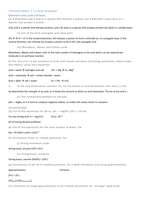Acids and bases a leve Study guides, Revision notes & Summaries
Looking for the best study guides, study notes and summaries about Acids and bases a leve? On this page you'll find 9 study documents about Acids and bases a leve.
All 9 results
Sort by

-
AQA A Level Chemistry 3.1.12 - Acids and Bases Graded A+
- Exam (elaborations) • 4 pages • 2024
-
- £10.14
- + learn more
AQA A Level Chemistry 3.1.12 - Acids and Bases Graded A+ Bronsted-Lowry acid Bronsted-Lowry base Proton donor Proton acceptor pH Measure of acidity by measuring concentration of H⁺ ions. Low pH means Acidity High pH means Alkalinity Calculating pH Calculating [H⁺] [H⁺] = 10 pH = -log [H⁺] -pH What does an acid/base reaction involve? Strong acid Fully dissociates in water. Transfer of the H⁺ from the acid to the base. Weak acid Only very slightly dissocia...
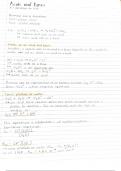
-
AQA A level chemistry acids and bases revision notes
- Summary • 10 pages • 2023
- Available in package deal
-
- £3.49
- + learn more
A helpful and comprehensive set of revision notes covering the entire acids and bases unit of AQA A level chemistry
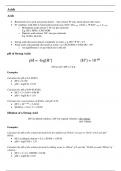
-
AQA A Level Chemistry - Unit 3.1.12: Acids and Bases - Full Notes
- Summary • 8 pages • 2023
-
- £3.99
- + learn more
Detailed and comprehensive notes on unit 3.1.12 (acids and bases) for AQA A level chemistry. Covers: acids, strong acid calculations, pH, ionisation of water (Kw), bases, strong base calculations, reactions of strong acids and bases, acid dissociation constant (Ka), pKa, reactions of weak acids and bases, buffers and buffer calculations. Includes example calculations for all possible types of pH calculation.
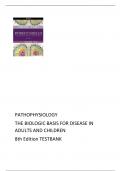
-
PATHOPHYSIOLOGY THE BIOLOGIC BASIS FOR DISEASE IN ADULTS AND CHILDREN 8th Edition TESTBANK (2)
- Exam (elaborations) • 713 pages • 2024
-
- £15.80
- + learn more
PATHOPHYSIOLOGY THE BIOLOGIC BASIS FOR DISEASE IN ADULTS AND CHILDREN 8th Edition TESTBANK Chapter 01: Cellular Biology MULTIPLE CHOICE 1. Which statement best describes the cellular function of metabolic absorption? a. Cells can produce proteins. b. Cells can secrete digestive enzymes. c. Cells can take in and use nutrients. d. Cells can synthesize fats. ANS: C In metabolic absorption, all cells take in and use nutrients and other substances from their surroundings. The remaining o...
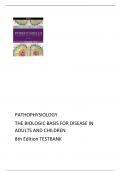
-
PATHOPHYSIOLOGY THE BIOLOGIC BASIS FOR DISEASE IN ADULTS AND CHILDREN 8th Edition TESTBANK (2)
- Exam (elaborations) • 713 pages • 2024
-
- £16.63
- + learn more
PATHOPHYSIOLOGY THE BIOLOGIC BASIS FOR DISEASE IN ADULTS AND CHILDREN 8th Edition TESTBANK Chapter 01: Cellular Biology MULTIPLE CHOICE 1. Which statement best describes the cellular function of metabolic absorption? a. Cells can produce proteins. b. Cells can secrete digestive enzymes. c. Cells can take in and use nutrients. d. Cells can synthesize fats. ANS: C In metabolic absorption, all cells take in and use nutrients and other substances from their surroundings. The remaining o...
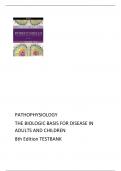
-
PATHOPHYSIOLOGY THE BIOLOGIC BASIS FOR DISEASE IN ADULTS AND CHILDREN 8th Edition TESTBANK (2)
- Exam (elaborations) • 713 pages • 2024
-
- £16.22
- + learn more
PATHOPHYSIOLOGY THE BIOLOGIC BASIS FOR DISEASE IN ADULTS AND CHILDREN 8th Edition TESTBANK Chapter 01: Cellular Biology MULTIPLE CHOICE 1. Which statement best describes the cellular function of metabolic absorption? a. Cells can produce proteins. b. Cells can secrete digestive enzymes. c. Cells can take in and use nutrients. d. Cells can synthesize fats. ANS: C In metabolic absorption, all cells take in and use nutrients and other substances from their surroundings. The remaining o...

-
AQA A Level Chemistry Paper 1 2022(• 3.1.12 Acids and bases X • 3.2.5 Transition metals (It's own set) X • 3.2.3 Group 7(17), the halogens X • 3.1.1 Atomic structure X • 3.1.3 Bonding X • 3.1.10 Equilibrium constant Kp for homogeneous systems X)
- Exam (elaborations) • 8 pages • 2022
-
- £10.54
- + learn more
Bronsted-Lowry acid a proton donor. Bronsted-Lowry base proton acceptor 00:14 01:38 What is H3O+? hydronium ion definition of pH -log10[H+] How do you get [H+] from ph? 10^(-pH) the ionic product of water [OH-][H+] Is dissociation an endo or exothermic reaction? endothermic Why is the concentration of water not included in Kw? The concentration of water is so large and constant the equilibrium equation can be simplified How does temperatu...
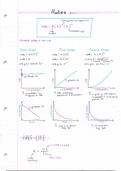
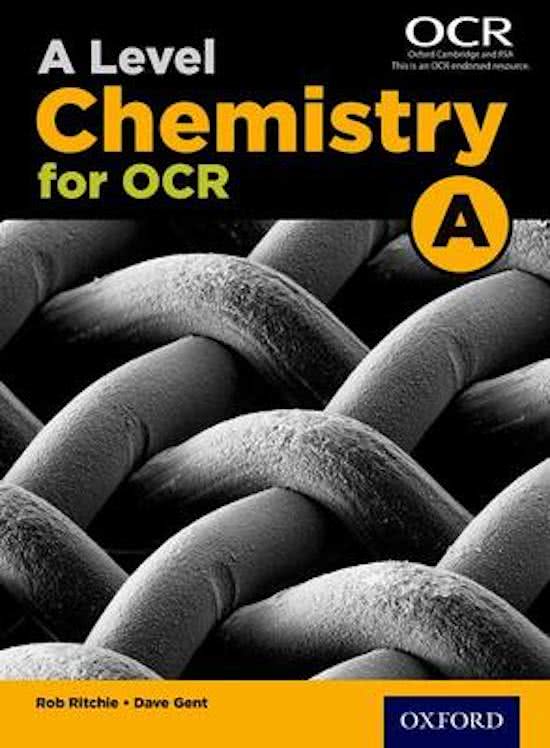
-
A level Chemistry (OCR 2015)- Module 5- Physical chemistry and transition elements (A* summary notes)
- Summary • 24 pages • 2020
- Available in package deal
-
- £4.49
- + learn more
Very detailed summary notes covering Module 5 of A Level Chemistry OCR A (2015). They cover every single specification point. A* study notes.
Summary of a level chemistry a acids and bases for ocr a level chemistry a (2015)

That summary you just bought made someone very happy. Also get paid weekly? Sell your revision notes on Stuvia! Discover all about earning on Stuvia



